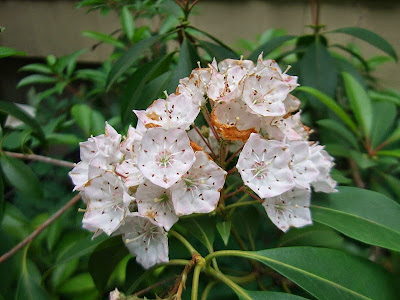Type of Flower
Mountain Laurel:
Mountain Laurel or Kalmia latifolia, commonly called mountain-laurel,calico-bush,or spoonwood is a species of flowering plant in the blueberry family, Ericaceae, that is native to the eastern United States. Its range stretches from southern Maine south to northern Florida, and west to Indiana and Louisiana. Mountain-laurel is the state flower of Connecticut and Pennsylvania. It is the namesake of the city of Laurel, Mississippi (founded 1882).
It is an evergreen shrub growing to 3–9 m tall. The leaves are 3–12 cm long and 1–4 cm wide. Its flowers are round, ranging from light pink to white, and occurring in clusters. There are several named cultivars today that have darker shades of pink, near red and maroon pigment. It blooms in May and June. All parts of the plant are poisonous. Roots are fibrous and matted.
The plant is naturally found on rocky slopes and mountainous forest areas. It thrives in acidic soil, preferring a soil pH in the 4.5 to 5.5 range. The plant often grows in large thickets, covering great areas of forest floor. In North America it can become tree sized on undeveloped mountains of the Carolinas but is a shrub farther north.The species is a frequent component of oak-heath forests.
Mountain laurel is poisonous to several different animals due to grayanotoxin and arbutin,including horses,goats, cattle, deer, monkeys and humans.The green parts of the plant, flowers, twigs, and pollen are all toxic,including food products made from them, such as toxic honey that may produce neurotoxic and gastrointestinal symptoms in humans eating more than a modest amount.Fortunately the honey is sufficiently bitter to discourage most people from eating it, whereas it does not harm bees sufficiently to prevent its use as winter bee fodder. Symptoms of toxicity begin to appear about 6 hours following ingestion.Symptoms include irregular or difficulty breathing, anorexia, repeated swallowing, profuse salivation, watering of the eyes and nose, cardiac distress, incoordination, depression, vomiting, frequent defecation, weakness, convulsions, paralysis, coma, and eventually death. Autopsy will show gastrointestinal irritation and hemorrhage.
The plant was originally brought to Europe as an ornamental plant during the 18th century. It is still widely grown for its attractive flowers. Numerous cultivars have been selected with varying flower color. Many of the cultivars have originated from the Connecticut Experiment Station in Hamden and from the plant breeding of Dr. Richard Jaynes. Jaynes has numerous named varieties that he has created and is considered the world's authority on Kalmia latifolia.
The wood of the mountain laurel is heavy and strong but brittle, with a close, straight grain.It has never been a viable commercial crop as it does not grow large enough, yet it is suitable for wreaths, furniture, bowls and other household items.It was used in the early 19th century in wooden-works clocks.Burls were used for pipe bowls in place of imported briar burls.It can be used for handrails or guard rails, specifically mountain laurel handrail.
References:http://en.wikipedia.org/wiki/Kalmia_latifolia

























No comments:
Post a Comment